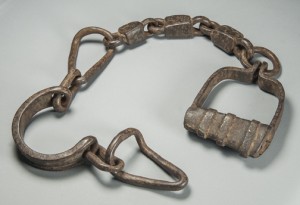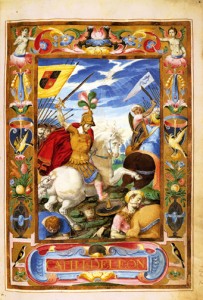
Shackles from the Inquisition prison in Mexico City, 17th century. Private collection. Photo by Jorge Pérez de Lara.
In the 10th through 13th centuries, Spain flowered into a golden age, as Muslim, Jewish and Catholic peoples achieved new heights in science, philosophy and the arts. That triculturalism, though, endured repeated challenges, first by fundamentalist Islamic Almohads in the 12th century, then by Christian kingdoms in the late-14th century, when it finally deteriorated into dissent, segregation and riots.
By 1492, when King Ferdinand and Queen Isabella unified the nation under the Catholic crown, cultural chaos roared forth. A royal edict ordered all Jews to either leave the country or convert to Catholicism within four months—or else. (A similar edict befell Muslims in 1502.) The Spanish Inquisition (and later, the Portuguese and Mexican Inquisitions) stood ready to persecute any Christian who failed to abide. Violators endured prisons, torture and death.
What would you do? Repudiate the language, religion and customs of your people in order to stay in your home and with your family? Or walk away from all you owned, all you knew, and embark upon treacherous journeys across land and sea toward a life you could barely imagine?
Fractured Faiths: Spanish Judaism, The Inquisition, and New World Identities, opening May 22, 2016 (tentatively through December 31, 2016), stands on the brink of that chasm and leaps into a diaspora that dates to biblical times. For the first time, a major institution tells the comprehensive story of how Spain’s Jewry found a tenuous foothold in North America. Despite continued persecution and investigation, its people persisted—sometimes as upright Catholic conversos, sometimes as secret “crypto-Jews”—to finally make a mark as successful merchants, artists and philanthropists in New Mexico. Emblems of that struggle for cultural identity appear even today: A menorah carved into a tombstone in a Catholic cemetery; oral histories of tangled roots; Hispanic villages where genetic clusters speak to Jewish lineage.
Working with institutions in Spain, Mexico City and New York, curators Josef Díaz and Roger Martínez-Dávila have gathered physical evidence, including trial testimony, 15th-century tiles from El Transito Synagogue in Toledo, an 18th-century painting of a Mexico City auto-da-fé, family trees that appear to scrub out evidence of Jewish heritage (at left), silver Purim groggers, and more. They bring to life people like Don Bernardo López de Mendizábal, a 17th-century governor of New Mexico, and his wife, Doña Teresa Aguilera y Roche. Hauled before the Inquisition in Mexico City, they were charged with—though never convicted of—being secret Jews.
Fractured Faiths reunites Spanish artifacts with their New World counterparts for the first time to reveal the history of the Spanish Sephardim—the stalwarts, the converts and the hidden Jews—and their long heritage within the Americas. A global story that played out on New Mexico soil, this monumental exhibit details one of history’s most compelling chronicles of human tenacity and the power of cultural identity.
In concert with the exhibit, Fresco Fine Art Publications will produce a bilingual catalog of the exhibition’s most important artifacts and documents. A programming series will deepen visitors’ understanding of Jewish life in the Americas and the struggle to preserve identity against often tragic odds. Lending institutions to Fractured Faiths include Spain’s Museo de Teruel, Biblioteca Nacional de España, and Museo Sefardí; Mexico City’s Museo Franz Mayer and the Museo Nacional de Arte; and the Hispanic Society of America in New York City.

